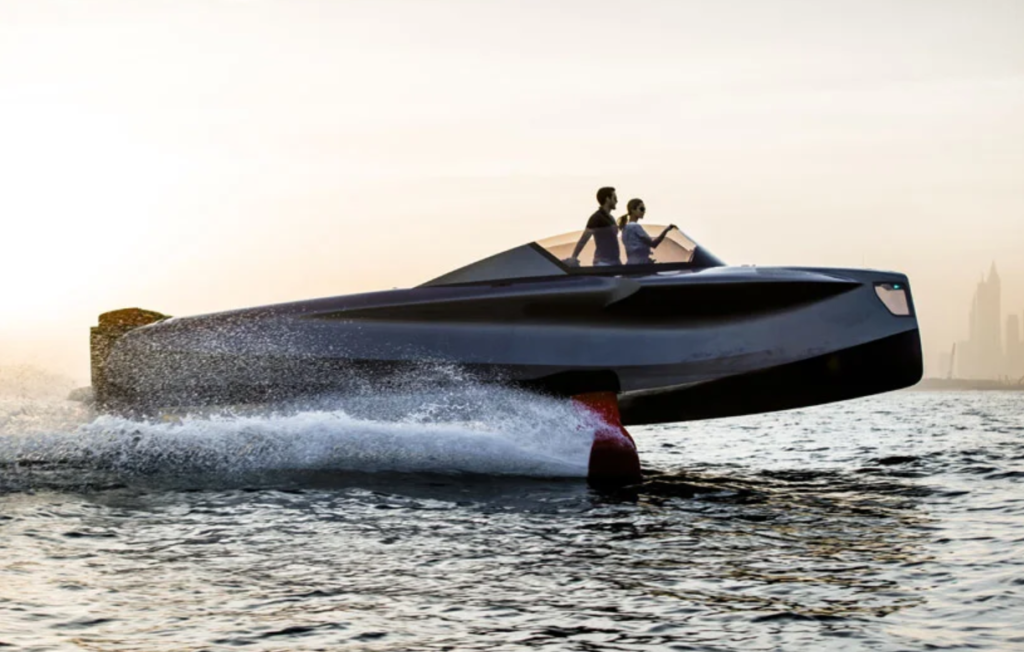
Austral Electronics proposes to accompany you for all types of hydrofoil boats and types of propulsion.
The advantages of flying boats
- Powerboats :
- Speed
- Reduction of fuel consumption from 30% (profile J) to 50% (profile T reversed) at the same speed
- Reduction of power and therefore of the cost of the motorization.
No extra cost for a production boat (foils and FCS compensated by a thermal motorization or battery half as powerful) - Improved comfort from 50 to 90% (T foils cross the waves)
- Reduction of the wake (protection of the banks)
- Sailboats : Gain in performance :
- Reduction of drag
- Increased stability: Better airflow and therefore more sailing power
- Gain in power / safety by the dynamic control of the Righting Moment
- Military ships :
- Stability of weapon systems
- Reduction of the acoustic signature (engine 2 times less powerful)
- Reduction of the optical and radar signature of the wake
- Avoidance maneuverability: Doubled turning speed and possible inward tilt of the turn
- Reduced susceptibility to mines and torpedoes
The problematic of foilers
This article (in French) from the EXperts Yachts blog describes the problems of flying boats.
In short : Flying is a balancing act on a wire shaken by the wind and the waves.
- If the foils are efficient (T or L shaped), the boat is unstable.
In manual piloting, in maneuvers, in unstable wind or rough seas, it quickly exceeds human capabilities and a flight controller becomes mandatory - If we accept to lose performance (J-shaped foil), the boat is self-stable.
Manual piloting is possible, but flight control improves performance and safety (stability, control of the RM/leeway, take-off assistance and flight maintenance, supervision of the flight envelope)
The Flight Control System (FCS)
The proposed solution is robust, the FCS constantly estimates the forces and moments in presence in order to balance them as instantaneously as possible.
It is multi-objective and allows the following controls: :
- In ride height
- In pitch
- Heeling / Righting Moment (Optional for small sailboats)
- Yaw (Optional)
- Speed (Optional)


Numerous architectures are possible, depending on the number and topology of the foils, the efforts defining whether the cylinders are electric or hydraulic, whether the hydraulics are centralized or distributed.
In the case of a small monohull, the FCS is typically made up of :
- A CANbus preferably dedicated.
- ESPRIT servo controls connected to actuators and feedbacks and operating whole foils or flaps.
- One or more altimeters.
- A QUANTUM ULTIMA computer, with ‘Flight Control System’ option, connected to an INS (and to the on-board instruments on sailboats).
- A User Interface :
- Dashboards and graphs in a Web browser.
- A simple and robust external HMI.
Our services
Austral Electronics offers you a solution adapted to your needs, from prototype to series, for all types of hydrofoil vessels and propulsion systems.
We use the Quantum rapid development platform in order to control costs and delays. In addition, we have designed our products at a target cost in order to meet mass production requirements..
Austral’s creator is a pioneer in the field of flight control, he has experience in modeling, simulation and control of several flying, self-stable or unstable competition sailboats, from 35 feet catamaran to 100 feet trimaran..
In a continuous improvement approach, we have engaged in R&D topics oriented Foilers:
- The intelligent FCS in Unsupervised Learning Control (currently being qualified for yaw control)
- Innovative sensors and algorithms to improve the quality of regulation and anticipation, and therefore safety and performance in heavy seas, as well as energy efficiency.

- Collection of architectural data.
- Assistance in the pre-sizing of motors/pumps/cylinders, energy, choice of feedbacks.
- Design of servo systems adapted to the needs, topology and available input data :
- Determination of the most appropriate controls
- Altitude management
- Pitch management
- Heel & Righting Moment management
- Yaw management for performance or safety
- Leeway management
- Simulation:
- Testing of different types of relevant servo systems.
- Verification of control performance as a function of disturbances, actuator speeds and energy optimization strategy.
- Sizing compromise.
- Take-off assistance and flight maintenance strategy (100% flight time objective).
- Supply of equipment (Calculator, Servo-controls, Altimeters, HMI…)
- Installation support: Settings, Commissioning
- Qualification : Sea trials, analysis of records / Machine learning, system improvement.
- Training